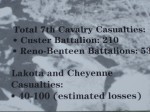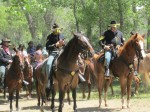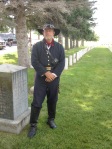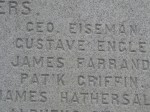 In the fall of 1868, General Sheridan recalled Custer from his yearlong suspension to lead the Seventh Cavalry in the new winter campaign. Upon his return from exile, he proceeded to turn the regiment inside out.
In the fall of 1868, General Sheridan recalled Custer from his yearlong suspension to lead the Seventh Cavalry in the new winter campaign. Upon his return from exile, he proceeded to turn the regiment inside out.
For ” Uniformity of appearance” he decided to ” color the horses.” All the regiment’s horses were assembled in a single group and divided up according to color. Four companies were assigned the bays ( brown with black legs, manes, and tails) three companies were given the sorrels ( reddish brown with same manes and tails); one company got the chestnuts; another brown; yet another blacks; and yet another the grays: ( white horses) with the leftovers, euphemistically referred to as the ” brindles” by Custer, going to the company commanded by the most junior officer.
It might be pleasing to the eye to assign a horse color to each company, cut Custer had, in one stroke, made a mockery of his officer’s efforts to provide their companies with the best possible horses. And besides, as every cavalryman knew, horses were much more than a commodity to be sorted by color. Each horse had a distinct personality, and over the course of the last year, each soldier had come to know his horse not only as a means of transportation but as a friend. ” This act,” Benteen wrote, ” at the beginning of a severe campaign was not only ridiculous, but criminal, unjust and arbitrary in the extreme.” But Custer was not finished. During his absence, he announced, the regiment had become lax in marksmanship. To address this failing, he established an elite corps of forty sharpshooters. He then named Benteen’s own junior Lt, William Cooke as the unit’s leader.  Benteen certainly did not appreciate these moves, but there was one officer who had even more reason to view them as a personal affront. Major Joel Elliott had assumed command during Custer’s absence. Elliott, just 28, was an ambitious and energetic officer; he had also done his best to quietly undercut his former commander, and Custer, Benteen knew it. By so brazenly establishing his own fresh imprint on the regiment, Custer had put Elliott on notice.
Benteen certainly did not appreciate these moves, but there was one officer who had even more reason to view them as a personal affront. Major Joel Elliott had assumed command during Custer’s absence. Elliott, just 28, was an ambitious and energetic officer; he had also done his best to quietly undercut his former commander, and Custer, Benteen knew it. By so brazenly establishing his own fresh imprint on the regiment, Custer had put Elliott on notice.
From the start, the regiment had expected cold and snow, but the blizzard they encountered before they left their base camp on the morning of November 23 was bad enough that even the architect of this ” experimental” winter campaign, General Sheridan, seemed reluctant to let them go. Already there was a foot of snow on the ground and the storm was still raging. ” So dense and heavy were the falling lines of snow,” Custer remembered, ” that all view of the surface of the surrounding country, upon which the guides depended…., was cut off.”
They were marching blind in the midst of a howling blizzard, and not even the scouts could tell where they where they were headed. Rather than turn back, Custer took out his compass. And so, with only his quivering compass needle to guide him, Custer ” like the mariner in mid-ocean,” plunged south into the furious storm.
That night, they camped beside the Wolf River in a foot and a half of snow. The next day dawned clear and fresh. Before them stretched an unbroken plain of glimmering white, and as the sun climbed in the blue, cloudless sky, the snow became a vast, retina-searing mirror. In an attempt to prevent snow blindness, the officers and men smeared their eyelids with black gunpowder.
beside the Wolf River in a foot and a half of snow. The next day dawned clear and fresh. Before them stretched an unbroken plain of glimmering white, and as the sun climbed in the blue, cloudless sky, the snow became a vast, retina-searing mirror. In an attempt to prevent snow blindness, the officers and men smeared their eyelids with black gunpowder.
Two days later, November 26, was the coldest day by far. That night, the soldiers slept with their horses’ bit beneath their blankets so the well-worn pieces of metal wouldn’t be frozen when they returned them to the animals’ mouths. To keep their feet from freezing in the stirrups as they marched, through a frigid, swirling fog, the soldiers spent much of the day walking beside their mounts. That afternoon they learned that Major Elliott, whom Custer had sent ahead in search of a fresh Indian trail, had found exactly that. On the night of November 27, they found Elliott and his men bivouacked in the snow.
Judging from the freshness of the trail, the Osage scouts were confident that a Cheyenne village was within easy reach. After a quick supper, they set out on a night march. The sky was ablaze with stars, and as they marched over the lustrous drifts of snow, the regiment looked, according to Lt Charles Brewster, like a huge black snake ” as it would around the tortuous valley.”
First they smelled the smoke; then they heard the jingling of a pony’s bell, the barking of some dogs, and the crying of a baby. Somewhere up ahead was the Indian village.
It was almost a windless night, and it was absolutely essential that all the noise be kept to a minimum as they crept ahead. The crunch of the horses’ hooves through the crusted snow as alarmingly loud, but there was nothing they could do about that. When one of Custer’s dogs began to bark, Custer and his brother Tom strangled the pet with a lariat. Yet another dog, a little black mutt, received a horse’s picket pin through the skull.
Custer and his officers observed the village from one of the surrounding hills. The tepees were clustered on a flat thirty-acre crescent on the Washita River. One of his officers asked, ” General, suppose we find more Indians there than we can handle?” Custer was dismissive, ” All I am afraid of is we won’t find half enough.”
Even though he was unsure of the exact number of tepees, Custer divided his command into 4 battalions. At dawn, he and the sharpshooters would attack from the north as Elliott came in from the east and another battalion from the South. Benteen was assigned to the battalion that was to attack from the west. The brass band, all of whom mounted on white horses, were to strike up ” Garry Owen” when it was time to charge the village.
The village was so quiet that Custer briefly feared the tepees were deserted. He was about to signal to the bandleader when a single rifle shot erupted on the far side of the village. The time to attack was now. Soon the ” rollicking notes.” of Garry Owen” were echoing improbably across the sno-covered hills, and the four battalions of the 7th Cavalry were galloping into the village.
Custer led the charge, his big black horse leaping across the river, Once in the village, he fired on one warrior and ran down another on his way to a small hill, where he established a command post. He had encountered almost no resistance in his charge to the hill, but such was not the case with the battalion to the west, led by Benteen. A Cheyenne teenager charged toward him with his pistol upraised. Not wanting to shoot someone he considered a non-combatant, Benteen gestured to the boy, trying to get him to surrender, but the your Cheyenne would have none of it. Three times he fired, narrowly missing Benteen’s head and wounding his horse before Benteen reluctantly shot the boy dead.
Benteen claimed that his company did most of the hard fighting that day, and ” broke up the village before a trooper of any of the other companies of the 7th got in.” He also took credit for rounding up the fifty or more Cheyenne women captives and for driving in the Indians pony heard of around 800 horses. ” I know that Custer had respect for me,” he later wrote, ” for at the Washita I taught him to have it.”
Lt Godfrey returned from pursuing Indians to the east with some disturbing news. Sever miles down the river, as another, much bigger village, and hundreds, if not thousands, of warriors were then galloping in their direction. Custer also learned that Major Elliott had chased another group of Indians in that direction but had not yet returned. Godfrey had heard gunfire during his foray east, might it have been Elliott? Custer, pondered this a bit, then said that he didn’t think so, claiming that another, officer had also been fighting in that vicinity and would have known if Elliott had been in trouble. And besides, they had other pressing concerns. They must destroy the Cheyenne’s most precious possession: the pony herd.
As the surrounding hills filled up with warriors from the village to the east, the troopers turned their rifles on the Ponies. It took an agonizingly long time to kill more than seven hundred horses. One of the captive Cheyenne women later remembered the very ” human” cries of the ponies, many of which were disabled and not killed by the gunfire. Private Dennis Lynch noticed that some of the wounded ponies ” had eaten all the grass within reach of them ” before they finally died.
Custer then ordered his men to burn the Village, The tepees and all their contents, including the Indians bags of gunpowder, were piled onto a huge bonfire. Each time a powder bag exploded, a billowing cloud of black smoke rolled up into the sky. All the while, warriors continued to gather in the hills around them.
Black Kettle’s now burning village contained exactly 51 lodges with about 150 warriors, giving the regiment a five to one advantage. But now, with warriors from what appeared to be a huge village to the east threatening to engulf them, the soldiers were, whether or not Custer chose to admit it, in serious trouble.
The scout Ben Clark estimated tha the village to the east was so big tha the odds had been reversed; the Cheyenne now outnumbered the troopers by five to one. But Custer wanted to hear none of it. They were going to attack the village to the east.
Clark vehemently disagreed. They were short of ammunition. Night was coming on. Victory was no longer the issue. If They were to get out of this alive, they must be both very smart and very lucky.
In My Life on the Plains, Custer took full credit for successfully extracting the regiment from danger. Ben Clark had a different view, claiming that he was the one who devised the plan. Once Clark had convinced Custer that attacking the other village was tantamount to suicide, Custer embraced the notion of trying to outwit the Cheyenne.
It was a maxim in war, Custer wrote, to do what the enemy neither ” expects nor desires you to do.” The Seventh Cavalry appeared to be hopelessly outnumbered, but why should that prevent it from at least pretending to go on the offensive? A faint toward the big village to the east might cause the warriors to rush back to defend their women and children. This would give the troopers the opportunity to reverse their field under the cover of night and escape to safety.
With flags flying and the band playing ” Aint I glad to Get out of the Wilderness”, Custer marched the regiment toward the huge village. Even before setting out, he’d positioned the Cheyenne captives along the flanks of the column. Sergeant John Ryan later remembered how the panicked cries of the hostages immediately caused the warriors to stop firing their weapons.
On they marched into the deepening darkness. Without warning, Custer halted the regiment, extinguished all lights, and surreptitiously reversed direction. By 10:pm they’d returned to the site of the original battle. By 2:am the troopers had put sufficient distance between themselves and the Cheyenne and camped for the night.
Several weeks later, they 7th Cavalry returned to the scene of the battle, When Custer and Sheridan rode into Black Kettle’s village, a vast cloud of crows leapt up cawing from the scorched earth. A wolf loped away to a nearby hill, where it sat down on its haunches and watched intently as they inspected the site. About two miles away, amid a patch of tall grass, they found Major Elliott and his men – ” sixteen naked corpses”, a newspaper correspondent wrote, ” frozen as solidly as stone”. The bodies had been so horribly mutilated that it was at first impossible to determine which one was Elliott’s.
Soon after, Benteen wrote the letter that was subsequently published in the St. Louis Newspaper. ” Who can describe the feeling of that brave band, ” he wrote, ” as with anxious beating hearts, they strained their yearning eyes in the direction whence help should come? What must have been the despair that, when all hopes of succor died out, nerved their stout arms to do and die?”
If Custer had committed one certain crime at the Washita, it involved not Major Elliott but the fifty or so Cheyenne captives who accompanied the regiment during the long march back to the base camp. According to Ben Clark ” many of the squaws captured at the Washita were used by the officers.” Clark claimed that the scout known as Romero ( jokingly referred to as Romeo by Custer) acted as the regiment’s pimp. ” Romero would send squaws around to the officer’s tents every night,” he said, adding that ” Custer picked out a fine-looking one ( named Monahsetah) and had her in his tent every night.”
So is the story of Custer’s leadership of the 7th Cavalry during the Battle of the Washita. The judgement of that leadership I’ll leave to the reader.
June 17, 2010
Categories: History Rants, US Army Horse Cavalry . Tags: 7th Cavalry, Battle of the Washita, Captain Frederick Benteen, Cheyenne Hostages, Cheyenne Village, Custer orders 700 horses shot, Custer's coloring the horses, Death of Major Joel Elliott, General Custer, General Sheridan, Lt William Cooke, Lt. Charles Brewster, Osage Scouts . Author: senseishaw . Comments: 1 Comment





















